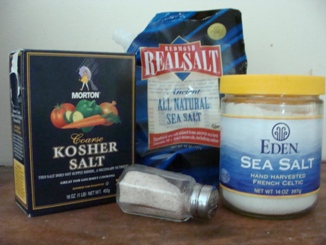Salt - Your New Friend

BUT - a person with orthostatic intolerance (OI) needs the salt - because it helps increase blood pressure and increase the volume of blood in the body!
In general, salt and water go together in the body. Salt is like a sponge. If you put a dry sponge near water, it soaks up the water. Salt "soaks up" water in the body too. The blood has salt in it and that helps keep water in the blood stream. Having enough blood volume so blood gets to your head keeps you from getting OI symptoms when you stand up.
People with OI have low blood volume. For people who had an event before the OI symptoms started, there was usually a period of bedrest, usually longer than a few days. During bedrest, the body decreases the volume of blood. It changes the message to the kidneys about salt and water. (Learn more about the effects of bedrest under Deconditioning.)
If bedrest lasts long enough, the body adjusts its internal message centers to that "lying down" becomes "normal". Keeping the body at low blood volume becomes the "normal".
Think of it like your TV, cable TV and your remote. To make cable work, you have to set the TV to Channel 3 and program your remote. If you change the TV channel to an other channel, it isn't recognized and you don't get any Cable TV. Everything has to get reprogrammed to work again. It's like that when you are on prolonged bedrest. Your body, especially the low blood pressure sensors get reprogrammed. They now think that lying down is "normal". They change all the messages they send out to your body when you stand up. The result - your blood drops to your feet when you stand up and you get dizzy .
When the volume of blood is low
The "normal" body reaction when the volume of blood is low - it holds on to more salt and water. A message is sent to the kidneys to tell them hold on to salt and water. This would increase the volume of blood.
With OI. There is a "dysfunction" or a miscommunication from your blood pressure sensor cells in your neck, the baroreceptor cells.
With OI, the baroreceptors have adjusted and now think that low blood volume is "normal". Your body doesn't send out the message to the kidneys to hold on to the salt and water and increase the blood volume.
If your body is not saving the salt and water, you have to help it! You have to take in more salt so your body will hold on to the water/liquid you take in. That's how you increase your blood volume.For more about orthostatic symptoms, amount of blood and the body's reactions, go to How the Body Works in Orthostatic Conditions
Some people with orthostatic intolerance (OI) have been able to control their OI symptoms with their salt and fluid intake.
ABOUT SALT:
• Salt
• Does it work?
• How much do I take?
• How to get started
• More about salt - table salt & tablets
• How do I know if I'm taking enough?
• Conversion Tables - Salt & Sodium
• Is it safe?
![]() Why You Need to Raise the Head of Your Bed - and How Much
Why You Need to Raise the Head of Your Bed - and How Much
References
- Figueroa JJ, Basford JR, Low PA. Preventing and treating orthostatic hypotension: As easy as A, B, C. Cleve Clin J Med. 2010 May;77(5):298-306. Abstract Article PDF
- Freeman, Roy. Neurogenic orthostatic hypotension.NEJM 2008;358(6):615-624. Abstract
- Claydon VE, Hainsworth R. Salt supplementation improves orthostatic cerebral and peripheral vascular control in patients with syncope. Hypertension. 2004 Apr;43(4):809-13. Epub 2004 Feb 23.
- El-Sayed H, Hainsworth R. Salt supplementation increases plasma volume and orthostatic tolerance in patients with unexplained syncope. Heart 1996; 75:134–140.
- Thieben MJ, Sandroni P, Sletten DM, et al. Postural orthostatic tachycardia syndrome: The Mayo Clinic experience. Mayo Clin Proc. 2007;82:308–313
- Personal experience of author.
- Wieling W, van Lieshout JJ, Hainsworth R. Extracellular fluid volume expansion in patients with posturally related syncope. Clin Auton Res 2002;12:242-9.
- Recommendations on salt.
 UK. Consensus Action on Salt & Health. Last accessed September 10, 2012.
UK. Consensus Action on Salt & Health. Last accessed September 10, 2012. - Rowe, Peter.General Information Brochure on Orthostatic Intolerance and Its Treatment. June 2010. Accessed from http://www.cfids.org/webinar/cfsinfo2010.pdf. Accessed May 28.2012.
- U.S. Department of Agriculture, Agricultural Research Service. 2011. USDA National Nutrient Database for Standard Reference, Release 24. Nutrient Data Laboratory Home Page ,http://www.ars.usda.gov/ba/bhnrc/ndl

- Low PA and Singer W. Update on Management of Neurogenic Orthostatic Hypotension. Lancet Neurol. 2008 May; 7(5): 451–458. Abstract. Article PDF.
- Low PA, Sandroni P, Joyner and Shen W. Postural Tachycardia Syndrome (POTS). J Cardopvasc Electrophysiology 2009; 20:352-358. Abstract. Article PDF
- Jacob G, Costa F, Shannon JR, Robertson RM et al. The Neuropathic Postural Tachycardia Syndrome. N Engl J Med 2000;343: 1008-14. Abstract. Article PDF.
- Fu Q, Vangundy TB, Galbreath MM, Shibata S, Jain M, Hastings JL, Bhella PS, Levine BD. Cardiac origins of the postural orthostatic tachycardia syndrome. J Am Coll Cardiol. 2010 Jun 22;55(25):2858-68. Abstract. Article PDF
- "Iodine in diet". MedlinePlus. External Link.
 Last accessed 09.13.2012
Last accessed 09.13.2012 - Dietary Supplement Fact Sheet: Iodine. Office of Dietary Supplements. National Institutes of Health. External Link
 . Last accessed 09.13.2012.
. Last accessed 09.13.2012. - Institute of Medicine. Dietary Reference Intakes for Vitamin A, Vitamin K, Arsenic, Boron, Chromium, Copper, Iodine, Iron, Manganese, Molybdenum, Nickel, Silicon, Vanadium, and Zinc. National Academy Press: Washington DC, 2001. 2001. External Link

Author: Kay E. Jewell, MD
Page Last Updated: September 13, 2012
